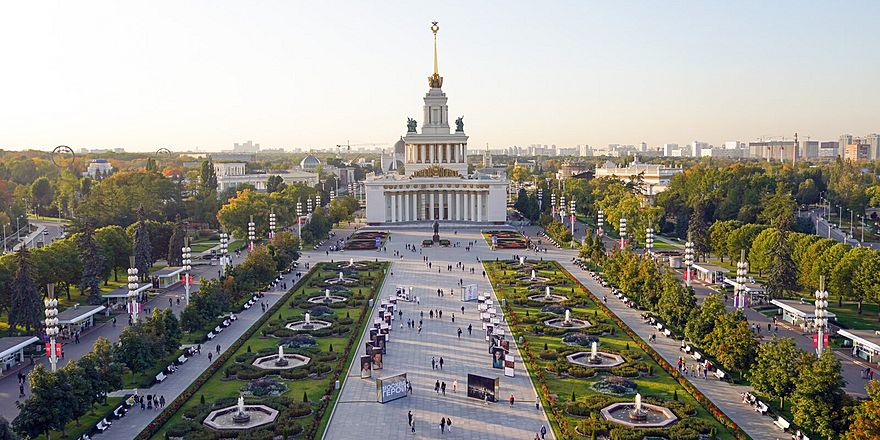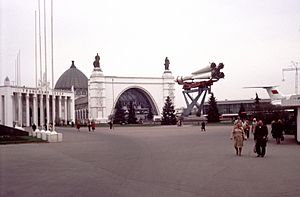Exhibition of Achievements of National Economy facts for kids
Quick facts for kids VDNKh |
|
|---|---|
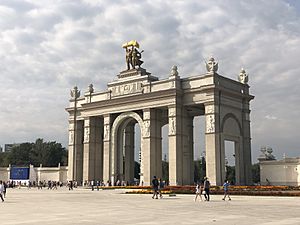
The main entrance to VDNKh
|
|
| Location | Moscow, Russia |
| Coordinates | 55°49′47″N 37°37′56″E / 55.82972°N 37.63222°E |
| Opened | 17 February 1935 |
|
Former names
|
All-Union Agricultural Exhibition (VSKhV) |
| Enclosed space | |
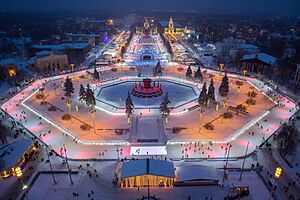
VDNKh (which stands for Vystavka Dostizheniy Narodnogo Khozyaystva in Russian) is a huge exhibition center and amusement park in Moscow, Russia. Its full name means "Exhibition of Achievements of National Economy." It's a place where people can see new inventions, learn about different industries, and have fun.
For a while, from 1991 to 2014, it was also known as the All-Russia Exhibition Centre. Today, it's still a very popular spot for both locals and tourists.
Contents
Finding VDNKh: Location and How to Get There
VDNKh is located in the Ostankinsky District of Moscow. It's less than a kilometer (about half a mile) from the famous Ostankino Tower.
You can easily get there by taking the Moscow Metro to the VDNKh subway station. There's also the Moscow Monorail that serves the area.
Right outside the main entrance, you'll find Cosmonauts Alley and the impressive Worker and Kolkhoz Woman statue. VDNKh is also next to the Moscow Botanical Garden and Ostankino Park. These three parks together form a huge green space for everyone to enjoy.
The Story of VDNKh: A Look Back in Time
Building the Exhibition: 1935–1939
VDNKh first started on February 17, 1935. Back then, it was called the All-Union Agricultural Exhibition (VSKhV). The idea was to show off the best of farming from across the Soviet Union.
The chosen spot was an area known as Ostankino Park, which had just become part of Moscow. A plan for the exhibition was approved in 1936. It was designed to be like a "City of Exhibitions" with its own streets and public areas. The first show was planned for July 1937.
However, building such a huge place was harder than expected. The opening was delayed several times. Some early buildings were even torn down because they weren't quite right. Finally, after many changes and delays, the exhibition officially opened on August 1, 1939. It stayed open for a few months that year, and then again in 1940 and 1941. But when World War II started for Russia in 1941, the exhibition had to close until the war ended.
Original Pavilions from 1939:
-
Pavilion of Kyrgyzstan
-
Pavilion of Belarus
-
Pavilion of Uzbekistan
-
Pavilion of Ukraine
-
Pavilion of North Caucasus
-
Pavilion of Turkmenistan
-
Pavilion of Armenia
Making it New: 1948–1959 Renovation
After World War II, in 1948, plans were made to reopen the exhibition. It was supposed to start again in 1950, but it was delayed once more. The first post-war season finally opened in 1954, still focusing on agriculture.
In 1956, a new "Industrial area" was added to the park. More changes and rebuilding happened after that. In 1959, the park got its current name: Exhibition of Achievements of the National Economy or VDNKh.
By 1989, VDNKh had 82 pavilions. These buildings covered a huge area of 700,000 square meters (about 7.5 million square feet). Each pavilion was dedicated to a specific industry or field. For example, there was an Engineering Pavilion (built in 1954) and a Space Pavilion (built in 1966). Other pavilions focused on topics like atomic energy, education, and radioelectronics.
During the Soviet era, VDNKh hosted over 300 national and international exhibitions each year. It was also a place for scientists and industry experts to meet and share ideas.
One of the most famous sights at VDNKh is the Worker and Kolkhoz Woman statue. This giant sculpture shows a man and a woman holding up a hammer and sickle. The sculpture is 25 meters (82 feet) tall. It was first made for the 1937 World's Fair in Paris.
VDNKh Today

In 1992, VDNKh was renamed VVC, but in 2014, its original name, VDNKh, was brought back after a public vote.
VDNKh is enormous, covering 2,375,000 square meters (about 587 acres). This is even bigger than the country of Monaco! It has around 400 buildings.
The famous Worker and Kolkhoz Woman statue needed a lot of repair work. It was taken apart and then put back together in 2009. Now, it stands on top of a large building that looks like the original pavilion from the 1937 World's Fair.
VDNKh is still a very active place. In winter, it turns into a giant ice skating rink, which is a popular attraction.
Recent Improvements and Restoration
On May 14, 2014, the name VDNKh was officially restored. The mayor of Moscow also announced that a real Russian space shuttle (a test version) would be moved to VDNKh. This shuttle, which used to be at Gorky Park, is now displayed near the Vostok rocket in front of the Cosmos hall. It was moved in July 2014.
Since 2018, many new things have happened at VDNKh. New museums and exhibition spaces have opened. A beautiful Landscape Park was created. Many old buildings that are cultural heritage sites have been restored. They even launched electric public transport to help people get around the huge park. In 2019, two famous fountains, "Fraternity of Peoples" and "Stone Flower," were fully restored and look amazing.
Exploring the VDNKh Site
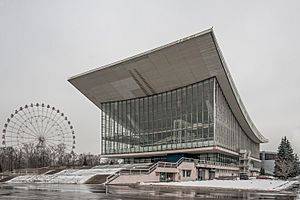

The VDNKh exhibition center was built during the time of Joseph Stalin. The chosen location was Ostankino, a northern part of Moscow. The main designer, Vyacheslav Oltarzhevsky, planned a central avenue with fountains and smaller roads. At the end of this avenue, there's a large square facing the central pavilion.
A beautiful fountain called "The Stone Flower Fountain" faces the Ukraine Pavilion. There's also a smaller square near the Space Pavilion. In the past, a Tupolev Tu-154 aircraft used to be displayed there. This aircraft was removed in 2008. This square is known as The Industrial Square.
The famous Worker and Kolkhoz Woman sculpture was originally made to be placed on top of the Soviet pavilion at the 1937 World's Fair in Paris. At that fair, the Soviet and Nazi pavilions were placed facing each other.
See also
 In Spanish: VDNJ (Rusia) para niños
In Spanish: VDNJ (Rusia) para niños


